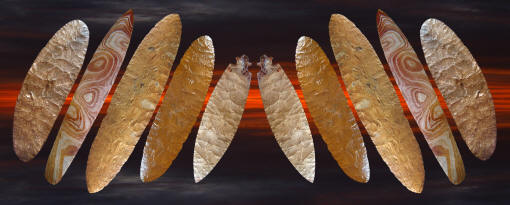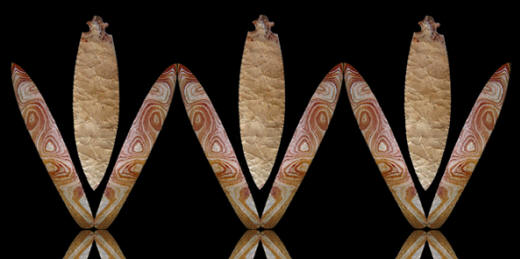|
"The long finely chipped
chert blades constitute one of the outstanding categories of artifacts
from the Spiro site."---1952, Henry W.
Hamilton, "The Spiro Mound," p. 43.
"Among this group (of Spiro
chert blades) are both concave and
straight base unnotched blades, plain side-notched types, long double
pointed notched or elliptical blades, multiple-notched, "turkey tail,"
and stemmed types."---1952, Henry W.
Hamilton, "The Spiro Mound," p. 43.
"Chipped-stone working (during
the Caddoan Spiro Phase in the Arkansas Valley)
was diverse and refined. Materials ranged greatly in size and quality."---1984,
James A. Brown, "Prehistory Of Oklahoma," p. 246.
"A total of 15 stone maces are known to
have come from the (Spiro Mounds)
site---. Three chipped maces of chert, according to Robert E. Bell, were
found in a cache during August 1935 together with 17 blades---."---1984,
James A. Brown, "Prehistory Of Oklahoma," p. 246.
"The distribution
and use of the Mill Creek chert "ceremonial" blades were quite distinct
from those of the hoes. Maces seem to be the rarest item in this
category, and finds include the burial interment at the Lilbourn site
and one from the Craig Mound at the Spiro site in eastern Oklahoma."---2000,
Charles R. Cobb, "From Quarry To Cornfield, The Political Economy
Of Mississippian Hoe Production" p. 70.
"The eccentric types
made from Mill Creek chert and other silicious materials often have
pigment residues, primarily in red, green, and yellow; in some cases the
implements may have been painted, in others the residues may have rubbed
on as a direst result of tool use."---2000,
Charles R. Cobb, "From Quarry To Cornfield, The Political Economy
Of Mississippian Hoe Production" p. 70.
"They (Mississippian
ceremonial artifacts) express the
sacred spiritual and divine in a visual language conveying the essence
of dynamic life forces and the duality of animals, humans and gods,
defining the role and status of these figures in the sacred landscape
and their power in the paranormal realm."---2004,
Susan C. Power, "Early Art Of The Southeastern Indians, Feathered
Serpents & Winged Beings," p. 259.

LARGE SPIRO MOUND BIFACES
SPIRO MOUND SITE
LE FLORE CO., OKLAHOMA
MISSISSIPPIAN PERIOD
There were two phases of excavation of the "Great temple Mound," also
known as Craig Mound, on the Spiro Mounds site in eastern Oklahoma. The first involved the
Pocola Mining Company who leased the site for $50. in 1933 and the second was
the WPA government worker project. All of the artifacts illustrated in
this article are reported to have been excavated by the Pocola Mining
Company. Over the years, the Pocola Mining Company's artifacts have been dispersed to private and institutional
collections across the country and the world.
|
|
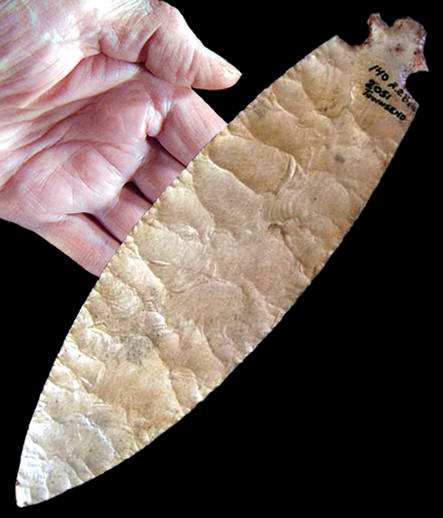
PHOTO OF BIFACE CREDIT, CHRIS MERRIAM
CLICK ON PICTURE FOR TRIPLE IMAGE OF BIFACE
NOTCHED STEM BIFACE
SPIRO MOUND SITE
LE FLORE CO., OKLAHOMA
MISSISSIPPIAN PERIOD
This is one of the finest flaked but most peculiarly shaped bifaces
that was found during the excavation of Craig Mound. The biface was
impressively shaped and thinned with skillfully done percussion
flaking on both sides and fine pressure flaking along the edges. The
quality and style of flaking on this biface compares to some Ramey
knives from Cahokia. The material is good quality chert that hasn't
been positively identified yet. The "exotic" style of this biface
does not conform to any known established point type. The base has a
notched stem instead of a rounded or pointed base like most bifaces
from the Spiro Caddoan region. At least one other example of these
odd biface types was found in Craig Mound which is illustrated by Hamilton.
Although only half of the point was found it measures 7 inches (17.8
cm) long, 3 1/4 inches (8.3 cm) wide and 5/16 inch (7.5 mm) thick. This biface measures 8 1/2 inches (21.6 cm)
long. |
|
|
It's
regrettable that more of the Pocola Mining Company's excavation wasn't
accurately recorded. Most of what was recorded was done by Robert Bell
who was a high school student at the beginning of the excavation and
later began attending Ohio State University in 1936. But what's even more remarkable is that he did it
in the 1930's and had to travel to Oklahoma from where he lived in Ohio.
Much of what is identified from the first phase of the Craig Mound
excavations comes from Robert Bell's photographs. Some of his black &
white pictures were used to illustrated a portion of this report. |
|
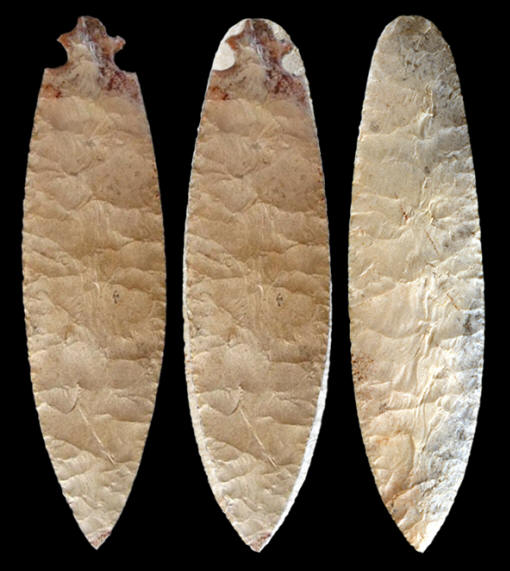
PHOTO OF CRAIG MOUND BIFACE--CREDIT CHRIS MERRIAM
COMPARISON OF THE NOTCHED
STEM
BIFACE TO A RAMEY KNIFE
CRAIG MOUND
SPIRO MOUND SITE
LE FLORE CO., OKLAHOMA
This
picture shows a comparison of the peculiar notched stem biface from
Craig Mound to a Ramey knife. Both of these bifaces have the same
thickness and shape. The flaking pattern is also very similar. Both
are made of a good quality chert. The Ramey knife is made of
Burlington chert. The center image shows the notched stem point
laying on top of the Ramey knife. The comparison illustrates how
remarkably close the preform of a Ramey knife is to that of the Craig
Mound biface. It would appear that this biface may have been made
from a Ramey knife. |
|
|
There were literally truck loads of artifacts excavated from Craig
Mound. The artifacts were manufactured from ceramic, copper, bone,
natural plant fibers, shell, pearls, stone and wood. The largest artifacts,
besides the mound itself, would be the cedar poles that constructed the
interior of the so called "central tomb" or mortuary. The
largest stone artifacts are represented by the different forms of large
bifaces. |
|
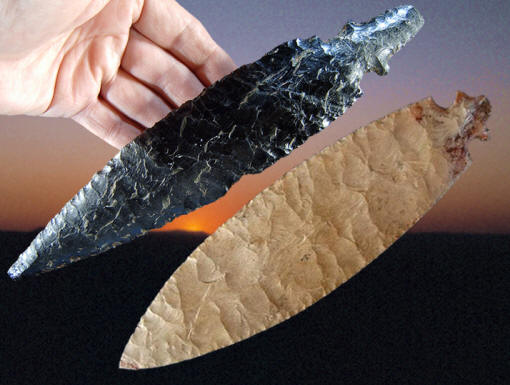
IMAGE OF CRAIG MOUND
BIFACE--CREDIT CHRIS MERRIAM
NOTCHED STEM BIFACES
MEXICO & OKLAHOMA
The author of this article knows of
only two locations where large notched stem bifaces were made in the
Americas. The black Obsidian point pictured above was collected
somewhere in Mexico many years ago. It measures 9 1/2 inches (24.1
cm) long. The other broken half of a notched stem biface that is illustrated by
Hamilton from Craig Mound has a longer stem than the complete Craig Mound example pictured
here. It's an odd basal design that may or may not have had any
design influence from people living far to the south in Mexico. The
design comparison must be made because an Obsidian flake is reported
to have been found during the excavation of Craig Mound and
Identified in a report published in "Scientific American" as having come from the central
valley of Mexico. |
|
|
Most of the large bifaces that were used by Mississippian cultures in
the eastern United States were agricultural and woodworking tools. These
are the spades and hoes that were manufactured in vast numbers to
cultivate fields of beans, corn and squash and the gouges and picks that
were used to shape the logs into canoes and a hundred other things. Most
of the rest of the large Mississippian bifaces can be categorized into
Ramey knives, Caddoan bifaces, "swords," maces and other miscellaneous
types of uniquely fanciful blades. These objects were used to represent
important religious concepts. Their shapes provided and projected
different mythological ideas. These are the bifaces that were used in
mortuary offerings or ceremonial events that involved such things as
dance swords. In-other-words, many of the large Mississippian bifaces
represented much more than a skillfully flaked artifact made of
beautifully colored stone. They could literally represent important gods
who maintained the earthly seasonal stability for humans. |
|
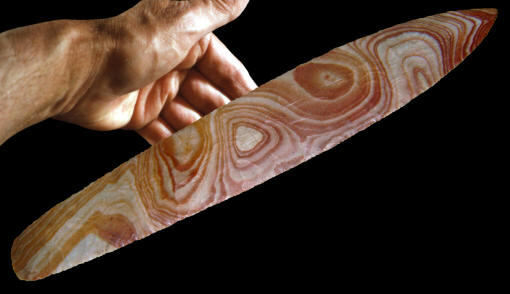
PRIVATE COLLECTION
CLICK ON PICTURE FOR LARGER IMAGE
MOST COLORFUL BIFACE
CRAIG MOUND
SPIRO MOUND SITE
LE FLORE CO., OKLAHOMA
This is the most remarkable biface or flint blade
that was found during the excavation of
Craig Mound on the Spiro Mound site. The color and banding pattern
on this biface is really quite
extraordinary. The stone must have cause some excitement when it was
discovered by the Mississippian quarrymen. Nothing quite like it has
ever been seen before. It was destined to fall into the hands of one
of the most skill flint craftsman of the time. The shape and style
of flaking is the same as some Ramey knives. Bifacial reduction was
done with very skillful shallow percussion flaking that generally
meets at the center of the medial ridge. The quality of the edge
work is also just as skillfully done with fine pressure flaking.
It's very likely that a Cahokia culture craftsman made this "gem" of
a biface. Hayden Vandagriff discovered it sometime in April of 1935.
He found it while digging in one of the smaller mounds or cones
located within the large saddle-shaped mound complex known as Craig
Mound. Robert Bell bought it in 1935 for his dad for $15.00. It
measures 13 1/8 inches long and 3/8 inch thick. Robert Bell
identified the material as Kay County chert from northern Oklahoma
but it may actually be Kaolin chert from southern Illinois.
This biface was exhibited in the "Hero, Hawk, and Open Hand"
exhibit at the Art Institute of Chicago and the
St. Louis Art Museum. |
|
|
Some writers are
beginning to suggest a stronger connection between the southeastern
Mississippian cultures in the U.S. and the central valley of Mexico. One
of the most interesting concepts are the large flint bifaces known as
Ramey knives. Cahokia
culture Ramey knives are very similar in shape to the decorated and
painted (personified) Aztec bifaces. Two
red and green painted
Ramey knives were found on the Loyd site under the wall of a
Mississippian house structure near Cahokia Mounds. Images of Aztec
bifaces were also represented as glyphs and drawn in manuscripts. In the
Aztec ritual calendar, they represent a day called "flint knife"
which is also an Aztec god. In the Central Valley of Mexico about 1200
A.D. some Mexica accounts describe a flint knife falling from the sky
that creates the world by issuing forth a god from each of the 1,600
broken chips. One of them is Quetzalcoatl, the feathered serpent. The
Aztecs sometimes used flint bifaces to represent Quetzalcoatl's feathers
on his cape or a tongue. In the Mixtec codex known as the Vindoborensis
a personified flint knife is shown giving birth to Quetzalcoatl,
complete with umbilical cord. These references indicate how much more
important the large Craig Mound bifaces may have been to the people who
placed them there. |
|
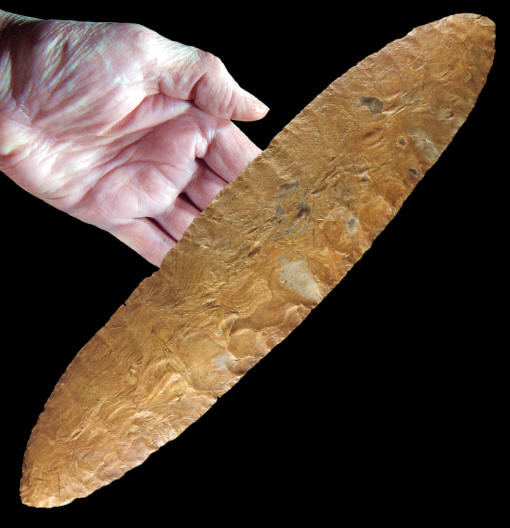
PRIVATE COLLECTION
CLICK ON PICTURE FOR LARGER IMAGE
CADDOAN ROUND-END BIFACE
SPIRO MOUND SITE
LE FLORE CO., OKLAHOMA
MISSISSIPPIAN PERIOD
This large and colorful blade is reported to have been found on the
Spiro Mounds site from Craig Mound. It measures 13 1/4
inches (33.6 cm) long. Perino describes these large bifaces as
round-ended knives. He refers to Hamilton's description of them in
1952 in which they are called "elliptical knives" and Brown's 1976
description of them as "socio-technic sword-form bifaces."
Perino describes them as long and parallel to slightly convex sided
bifaces with rounded ends. Round-end bifaces are skillfully made
with shallow
controlled percussion flaking that merges at the midsection.
Round-ended knives are reported to be found most often in mortuary
associations. They were also used in ceremonial events as dance
swords. |
|
|
In most cases, artifacts that have been excavated from mounds
in the U.S. are
identified specifically to the local community of people who built the
mound. Craig Mound is one exception, another would be Mound 72 at
Cahokia. The large bifaces that were excavated from Craig Mound do
exhibit a wide range of design features that originate from different
cultural areas. Some of the bifaces were made by local Caddoan
craftsmen. But other examples have design features that originate far to
the east in Illinois and Tennessee. |
|
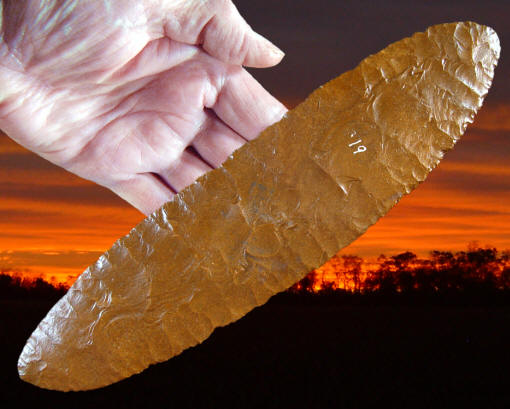
PHOTO OF BIFACE CREDIT, CHRIS MERRIAM
PRIVATE COLLECTION
CLICK ON PICTURE FOR LARGE TRIPLE IMAGE
CADDOAN ROUNDED-END BIFACE
SPIRO MOUND SITE
LE FLORE CO., OKLAHOMA
MISSISSIPPIAN PERIOD
This large biface was discovered during the excavation of Craig
Mound by the Pocola Mining Company workers. An old Robert Bell
picture shows it once in the Harry T. Bell collection. Perino
refers to these types of bifaces as Round-End knives and dates them
to Early Caddoan at Spiro sometime between A.D. 1100 to A.D. 1300.
This example is made of Smoky Hills silicified chalk from the
Niobrara geological formation. It measures 9 1/2 inches (24.1 cm) long
and 2 1/2 inches (6.3 cm) wide. |
|
|
The large Round-End Caddoan bifaces are local to Spiro and are often
found in a mortuary association. The longest bifaces from Craig Mound
are sometimes referred to as Spiro Swords. They have a long narrow shape
that seem to relate to Etowah type swords from Tennessee, Kentucky and
Georgia. Other bifaces like the notched stem blades may actually be
Ramey knives from Cahokia that were slightly altered into a fanciful
form like some of the arrow points that were found in Craig Mound. The
large bifacially flaked maces are also not a local artifact type. Most
examples have been reported from sites much farther to the east in Tennessee and Kentucky. So it would appear that the mortuary
ceremony at Craig Mound was important enough to bring in representatives
from far and wide, along with items of great importance. |
|
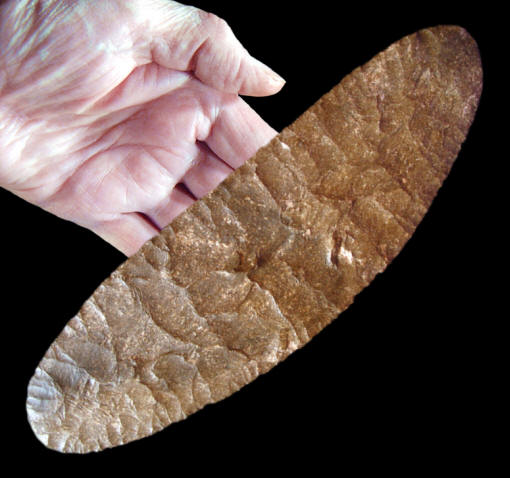
PHOTO OF BIFACE CREDIT, CHRIS MERRIAM
PRIVATE COLLECTION
CLICK ON PICTURE FOR LARGE TRIPLE IMAGE
CADDOAN ROUND-END BIFACE
SPIRO MOUND SITE
LE FLORE CO., OKLAHOMA
MISSISSIPPIAN PERIOD
This large Round-End Caddoan biface was discovered during the
excavation of Craig Mound by the Pocola Mining Company workers. It's
very skillfully made with percussion flaking. The shallow flakes
generally meet or cross over at the center.
The quality of the edge work is also just as skillfully done with
fine pressure flaking. |
|
|
The best argument for a non-local artifact source is
the identification of the material it was made from, in this case the
stone. Some of the bifaces from Craig Mound were made from Kay County
and other types of local cherts. But the large cache of "swords" and
maces that were found in the "central tomb" are identified as being made
from Mill Creek chert. The source for Mill Creek is southern Illinois
in the area around Union County approximately 350 miles east of the Spiro
site. The people living at Cahokia used notched hoes, spades and Ramey
knives that were made from Mill Creek chert. Mill Creek in its raw form
occurs in tabular plates that are perfect for the production of large
agricultural and ceremonial tools. Kaolin chert is another southern
Illinois stone that was used to make some of the Craig Mound polished
maces and at least one large extremely colorful biface. The source for Kaolin
chert is also in southern Illinois. |
|
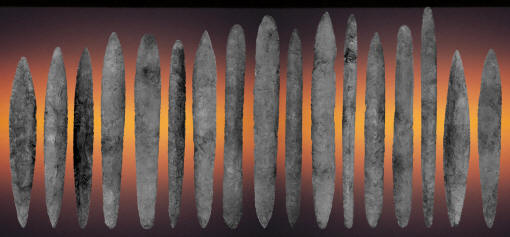
IMAGES OF BIFACES FROM ROBERT BELL'S PHOTO ALBUM
LITHIC CASTING LAB
COLLECTION OF IMAGES.
CLICK ON PICTURE FOR LARGER IMAGE
LARGE BIFACE "SPIRO SWORDS"
SPIRO MOUND SITE
LE FLORE CO., OKLAHOMA
MISSISSIPPIAN PERIOD
These seventeen large bi-pointed
bifaces were discovered during the excavation of Craig Mound. They
are sometimes referred to as "Spiro swords." This picture was put together by digitally
removing them from two old black & white photographs that were taken by
professor Robert Bell in August of 1935. All of them are reported to
have been found in one cache along with three maces that are
pictured below. None of these blades survived intact. It's believed
that they were "ceremonially broken." The longest blade to the right
measures 22 inches (55.9 cm) long. But the measurements may not be
completely accurate because some of the blades were not properly
restored. Some of them were restored correctly but when x-rays were
taken by Dr. P. F. Titterington it was determined that some of the
blades were put together with pieces that did not match their
connecting ends and had been stuck together with plastic wood
filler. Green paint was also used to simulate copper stains. In fact
when the person who bought them, Mr. Wehrle, put them into water to
clean them they begin to fall apart. |
|
|
The largest bifaces that were ever made in the United
States were made from either Obsidian from far western states, Mill
Creek chert from southern Illinois and Dover chert from Kentucky. Some
of the late Stone Age cultures in California were making Obsidian
ceremonial bifaces 30 or more inches long. The longest Dover chert
biface "sword" in the famous Duck River Cache from Tennessee measures
28 inches (71.1 cm) long. The longest
measurement given for the Mill Creek chert Spiro "swords" from Craig
Mound is 22 inches (55.9 cm) long. |
|
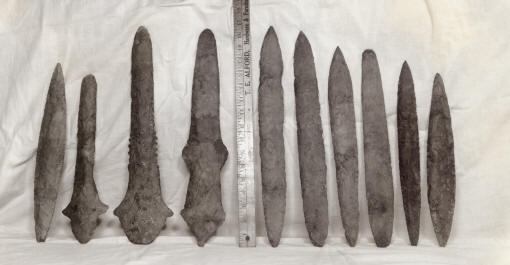
PHOTO FROM ROBERT BELL'S PHOTO ALBUM----LITHIC CASTING LAB
COLLECTION OF IMAGES.
CLICK ON PICTURE FOR LARGER IMAGE
"SWORDS" AND MACES FROM CRAIG MOUND
LONGEST IS 17 INCHES (43.2
CM) LONG
This old black & white photograph was
taken by professor Robert Bell in August of 1935. It shows seven of
the large "Spiro swords" and the three large maces that were found
together in a cache. The longest mace measures 16 3/8 inches (41.6
cm) long. |
|
|
The Craig Mound bifaces have been referred to by many
different names. Hamilton refers to the Craig Mound bifaces as, "concave
and straight base unnotched blades, plain side-notched types, long
double pointed notched or elliptical blades, multi-notched, turkey-tail,
and stemmed blades." Other names that have been used are, large blades,
large bifaces, ceremonial bifaces, chipped stone blades, chipped chert
blades, Spiro swords, dance swords, socio-technic sword form bifaces,
elliptical knives, round-end knives, maces, mace-form clubs, etc., etc.
There will never be a lack of descriptive terms to refer to any of the large
Spiro bifaces. |
|
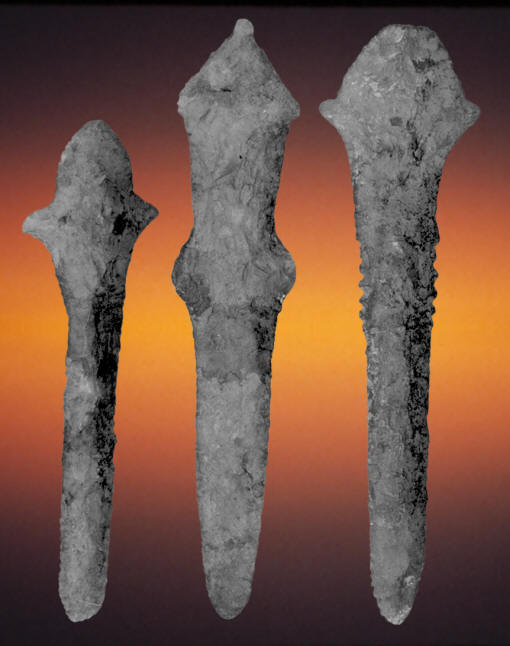
IMAGES OF BIFACES FROM ROBERT BELL'S PHOTO ALBUM
LITHIC CASTING LAB
COLLECTION OF IMAGES.
CLICK ON PICTURE FOR LARGER IMAGE
MACES
SPIRO MOUND SITE
LE FLORE CO., OKLAHOMA
MISSISSIPPIAN PERIOD
These three large bifaces were flaked
into three different forms of maces. They all have pointed
projections near one end with either serrations, rounded bulbous
projections or plain edges. All of them were discovered in a cache
with seventeen "swords." Hamilton reports that at least 15 stone
maces were found in Craig Mound. Some of them were flaked, like
these examples. The rest of them were polished to remove all or most
of the flake scars. Maces in the eastern United States date to
between A.D. 1000 to 1400. Their image appears on engraved shell and
copper. Merriam reports that these maces are made of
Mill Creek chert. Some of the polished examples were made of Kaolin
chert. The longest mace in this picture measures 16 3/8 inches (41.6 cm)
long. |
|
|
There are a fairly wide variety of different types and styles of
artifacts that appear in old photographs that are attributed to Craig
Mound. At first glance some of them seem out-of-place for
Mississippian cultures. Some appear to be older artifact types or not even
authentic. The problem with the earliest excavation of Craig mound
is that it was done by relic hunters who were operating a business
strictly for profit during a period of economic depression. They were
also interacting with artifact dealers who were
adding both fake and old but non-Spiro artifacts to the Craig Mound collection. For example, modern copper
rods were sold as old and old plummets were modernly altered with
fanciful engravings. |
|
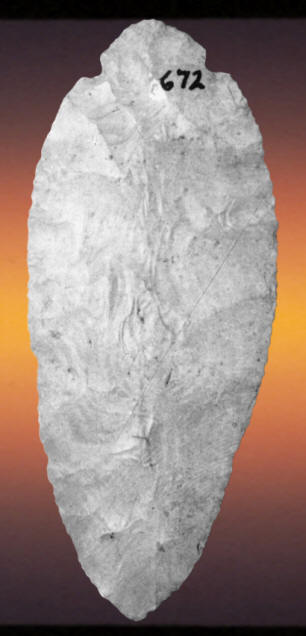
IMAGE FROM ROBERT BELL'S PHOTO ALBUM
LITHIC CASTING LAB
COLLECTION OF IMAGES.
NOTCHED BIFACE
SPIRO MOUND SITE
LE FLORE CO., OKLAHOMA
MISSISSIPPIAN PERIOD
This notched biface appears in one of
professor Robert Bell's photographs of Harry T. Bell's collection of
Craig Mound artifacts. No size is given but judging from an ear
spool in the original picture it seems to be at least 4 1/8 inches
(10.5 cm) long. It's described as a small light colored knife with a
turkey tail-like base probably made from Florence "B," Kay County
chert. A fairly wide variety of different types of small to
mid-range size bifaces are illustrated in books that represent
artifacts from Craig Mound. Two examples have tiny tangs on their bases
(basal tanged knives) which is a design that is attributed to the Archaic period.
Others, like this example, are bi-pointed bifaces with larger
notches near one end that give them a turkey tail design that is
similar to some types of Late Archaic Turkey Tail
points such as the Harrison type. In-other-words some of the bifaces
can be attributed to a more ancient time period. They do not fit the
traditional artifact styles of the Spiro Caddoan craftsmen or other
Mississippian period craftsmen in the region at the time Craig Mound
was built. But there are unique exceptions such as the notched stem
bifaces that were apparently made from Ramey knives and some arrow
points that are obviously exaggerated forms of Caddoan style points. |
|
|
The Craig Mound excavation received great notoriety when the
"central tomb" was discovered. Newspapers were comparing it to King
Tut's tomb. It was an extraordinary archaeological discovery but a dark
moment for science. But now, after all these years, the scale is leaning
towards a more positive conclusion. A great amount of knowledge has been
gained from all the chaos and destruction. |
|
"REFERENCES"
1935-1937, Robert Bells original photo album of black and white
photographs.
1952,
Hamilton, Henry W., "The Spiro Mound," The Missouri Archaeologist,
Vol. 14, October.
1976, Brown, James, "Spiro Studies, Vol. 4"
1978, Blake, Leonard, Houser, James G., "The Whelpley Collection
Of Indian Artifacts," plates 27 & 28 very large California bifaces.
1981, Brehm, H. C., "The History Of The Duck River Cache."
1984, Robert E. Bell, "Prehistory Of Oklahoma," p.247.
1985, Perino, Gregory, "Selected Preforms, Points And Knives Of
The North American Indians, Vol. 1," Duck River Swords, p. 108,
Ramey Knives, p. 314.
1991, Perino, Gregory, "Selected Preforms, Points And Knives Of
The North American Indians, Vol. 2," Round-End Knife, p.180.
1997, Hall, Robert, "An Archaeology Of The Soul," p. 111.
2000,
Charles R. Cobb, "From Quarry To Cornfield, The Political Economy
Of Mississippian Hoe Production" p. 70.
2003, Hathcock, Roy, "Prehistoric American," pp. 26-27.
2004, Merriam, Larry G., &
Merriam, Christopher J., "The Spiro Mound: A Photo Essay,"
2004,
Power, Susan C., "Early Art Of The Southeastern Indians, Feathered
Serpents & Winged Beings," p. 259.
2004, Townsend, Richard, F., "Hero Hawk And Open Hand," p. 34.
2007, Reilly III, F. Kent, Garber, James F, "Ancient Objects And
Sacred Realms, Interpretation Of Mississippian Iconography," Kehoe,
Alice Beck, Osage Texts And Cahokia Data, pp. 253-257.
Personal Communication with Jim Cox.
Personal Communication with James Marlen
Personal Communication with Chris Merriam
|
|
RECENT
LISTINGS HOME
ORDERING |
